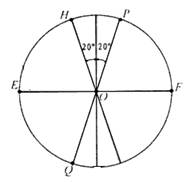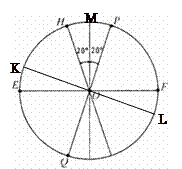下图表示“270N某地坡向(坡度为100)对地表获得太阳辐射的影响”,纵坐标表示该地坡面与地平面获得读图,完成:

小题1:若EF为赤道,P点出现极昼现象,则太阳直射的范围是
A.0°~20°N
B.0°~20°S
C.20°N~23°26′N
D.20°S~23°26′S小题2:若EF为地球公转轨道平面,PQ为地轴。下列变化可信的是
A.福州冬季均温升高
B.北温带范围变小
C.全球极夜范围扩大
D.悉尼(约34°S)夏季昼变长小题3:若O为北极点,H、P为晨昏线与某纬线的两个交点,则E点的时间可能为
A.5月23日8时
B.6月22日18时
C.l1月23日6时
D.12月11日18时
小题1:C
小题2:A
小题3:D
小题1:该题关键是对P点出现极昼现象和刚好出现极昼现象的区别,P点出现极昼现象可能的情况包括刚好出现极昼现象和P点及其以南的部分地区也出现极昼现象,P点刚好出现极昼现象时,由图中信息可知P点纬度为70°N,即太阳直射在20°N,P点及其以南的部分地区也出现极昼现象的最大范围是北极圈及其以北出现极昼现象,即太阳直射在23°26′N,所以P点出现极昼现象,则太阳直射的范围是20°N~23°26′N,选C。

小题2:EF为地球公转轨道平面,PQ为地轴,做地轴的垂直线KL(如上图),即KL为赤道,在赤道平面上,则此时黄赤交角为20°,即黄赤交角比原来变小了,则南北回归线的纬度为20°S/N,南北极圈的纬度为70°S/N,所以北温带的范围变大,全球极夜范围缩小,福州冬季时离太阳直射点最远的距离(冬至日太阳直射在20°S)变近了,则福州冬季均温升高,悉尼(约34°S,在南半球)夏季离太阳直射点最近(冬至日太阳直射在20°S)的距离变远了,则晨昏线与地轴夹角变小,昼夜差距缩小了,因而悉尼夏季昼变短了,即选A。
小题3:O为北极点,H、P为晨昏线与某纬线的两个交点,则可知弧HMP和弧HQP(如上图)对应该纬线上昼弧或夜弧,则有两种情况:①弧HMP为昼弧,则北半球昼短夜长,M所在经线平分白天即地方时为12时,E点位于M点的东侧经度相差90°,即E点的时间为18时,选项中有B、D项满足,但由于6月22日北半球昼长夜短,不符合条件,即D项满足;②弧HMP为夜弧,则北半球昼长夜短,M所在经线平分黑夜即地方时为0时,E点位于M点的东侧经度相差90°,即E点的时间为6时,选项中只有C项满足,但由于l1月23日北半球昼短夜长,即C项也可能。所以最终答案选D。
